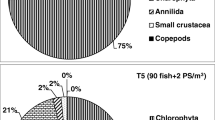Abstract
In areas impacted by acid precipitation, water chemistry of acidic ponds and streams often changes, resulting in increased mobilization of aluminum and decreased concentration of calcium carbonate. Aluminum binds with phosphorus and inhibits its uptake by organisms. Thus, invertebrate food organisms used by waterfowl may have inadequate Ca and P or elevated Al for normal growth and development. Acid rain and its effects may be one of the factors negatively impacting American black ducks (Anas rubripes) in eastern North America. One-day old mallards (A. platyrhynchos) and black ducks were placed on one of three Ca:P regimens: low:low (LL), normal:normal (NN), and low:high (LH) with each regimen divided further into three or four Al levels for 10 weeks. Forty-five % of the black ducks died on nine different diets whereas only 28% of the mallards died on three different diets. Mortality was significantly related to diet in both species. Growth rates for body weight, culmens, wings, and tarsi of both species on control diets exceeded those on many treatment diets but the differences were less apparent for mallards than for black ducks. Differences among treatments were due to both Ca:P and A1 levels.
Similar content being viewed by others
References
Bunck CM, Pendleton GW (1989) Multivariate curve-fitting in Gauss. Proc Stat Comput Sect Am Stat Assoc (in press)
Carriere D, Fischer KL, Peakall DB, Anghern P (1986) Effects of dietary aluminum sulphate on reproductive success and growth of ringed turtle-doves (Streptopelia risoria). Can J Zool 64:1500–1505
Deobold HJ, Elvejehm CA (1935) The effect of feeding high amounts of soluble iron and aluminum salts. Amer J Physiol 111:118–123
DesGranges JL, Rodrique J (1986) Influence of acidity and competition with fish on the development of ducklings in Quebec. Water Air Soil Pollut 30:743–750
Eriksson MOG (1979) Competition between freshwater fish and goldeneye (Bucephala clangula) for common prey. Oecologica 41:99–107
Freda J (1986) The influence of acidic pond water on amphibians: A review. Water Air Soil Pollut 30:439–450
Glooschenko V, Blancher P, Herskowitz J, Fulthrope R, Rang S (1986) Association of wetland acidity with reproductive parameters and insect prey of the eastern kingbird (Tyrannus tyrannus) near Sudbury, Ontario, Water Air Soil Pollut 30:553–567
Haines TA (1981) Acidic precipitation and its consequences for aquatic ecosystems: A review. Trans Am Fish Soc 110:669–707
Haines TA, Baker JP (1986) Evidence of fish population responses to acidification in the eastern United States. Water Air Soil Pollut 31:605–629
Haramis GM, Chu DS (1987) Acid rain effects on waterfowl: use of black duck broods to assess food resources of experimentally acidified wetlands. ICBP Tech Publ 6:173–181
Havas M, Hutchinson TC (1983) Effect of low pH on the chemical composition of aquatic invertebrates from tundra ponds at the Smoking Hills, N.W.T., Canada. Can J Zool 61:241–249
Hunter, Jr ML, Jones JJ, Gibbs KE, Moring JR (1986) Duckling responses to lake acidification: Do black ducks and fish compete? Oikos 47:26–32
LaZerte B (1986) Metals and acidification: An overview. Water Air Soil Pollut 31:569–576
Longcore JR, Ross RK, Fisher KL (1987) Wildlife resources at risk through acidification of wetlands. Trans N A Wildl Nat Res Conf 52:608–618
McAuley DG, Longcore JR (1988a) Survival of juvenile ring-necked ducks on wetlands of different pH. J Wildl Manage 52:169–176
—, — (1988b) Foods of juvenile ring-necked ducks: relationships to wetland pH. J Wildl Manage 52:177–185
McNichol DK, Bendell BE, McAuley DG (1987) Avian trophic relationships and wetland acticity. Trans N A Wildl Nat Res Conf 52:619–627
Morrison DF (1967) Multivariate statistical methods. McGraw-Hill, New York
Nyholm NEI (1981) Evidence of involvement of aluminum in causation of defective formation of eggshells and of impaired breeding in wild passerine birds. Environ Res 26:363–371
Nyholm NEI, Myhrberg HE (1977) Severe eggshell defects and impaired reproductive capacity in small passerines in Swedish Lapland. Oikos 29:336–341
Raddum GB, Steigen AL (1981) Reduced survival and calorific content of stoneflies and caddisflies in acid water. In: Singer R (ed) Effects of acid precipitation on benthos. N A Benthol Soc, Springfield, IL, pp 97–101
Rattner BA, Haramis GM, Chu DS, Bunck CM, Scanes CG (1987) Growth and physiological condition of black ducks reared on acidified wetlands. Can J Zool 65:2953–2958
Sadler K, Lynam S (1985) The mineral content of some freshwater invertebrates in relation to stream pH and calcium concentration. Tech Plan Res Div Cent Elec Res Lab
Scheuhammer AM (1987) The chronic toxicity of aluminum, cadmium, mercury, and lead in birds: a review. Environ Pollut 46:263–295
Siegel S (1956) Nonparametric statistics for the behavioral sciences. McGraw-Hill, New York
Sokal RR, Rohlf FJ (1969) Biometry. WH Freeman, San Francisco, CA
Steiner AJ (1984) Mid-winter waterfowl inventory Atlantic Flyway 1954–1984 trend analysis. U S Fish Wild Serv Region 5, Newton Corner, MA
Author information
Authors and Affiliations
Rights and permissions
About this article
Cite this article
Sparling, D.W. Acid precipitation and food quality: Inhibition of growth and survival in black ducks and mallards by dietary aluminum, calcium, and phosphorus. Arch. Environ. Contam. Toxicol. 19, 457–463 (1990). https://doi.org/10.1007/BF01054992
Received:
Revised:
Issue Date:
DOI: https://doi.org/10.1007/BF01054992




